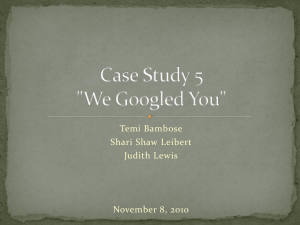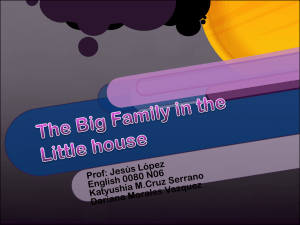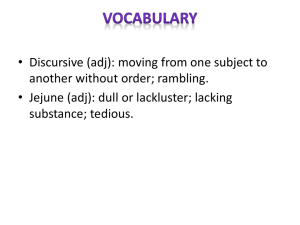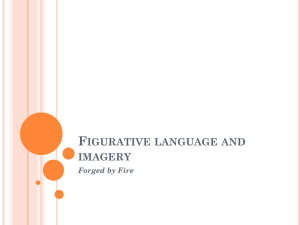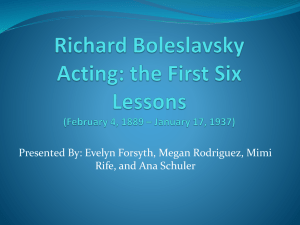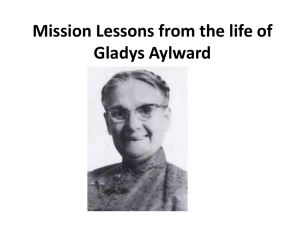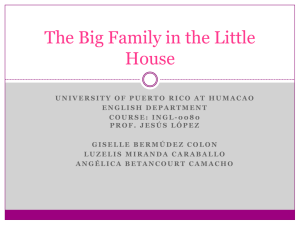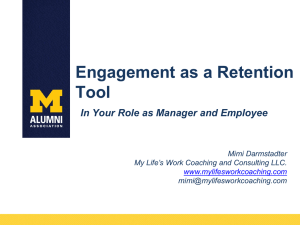A Note to Biographers Regarding Famous Author Flannery O`Connor
advertisement
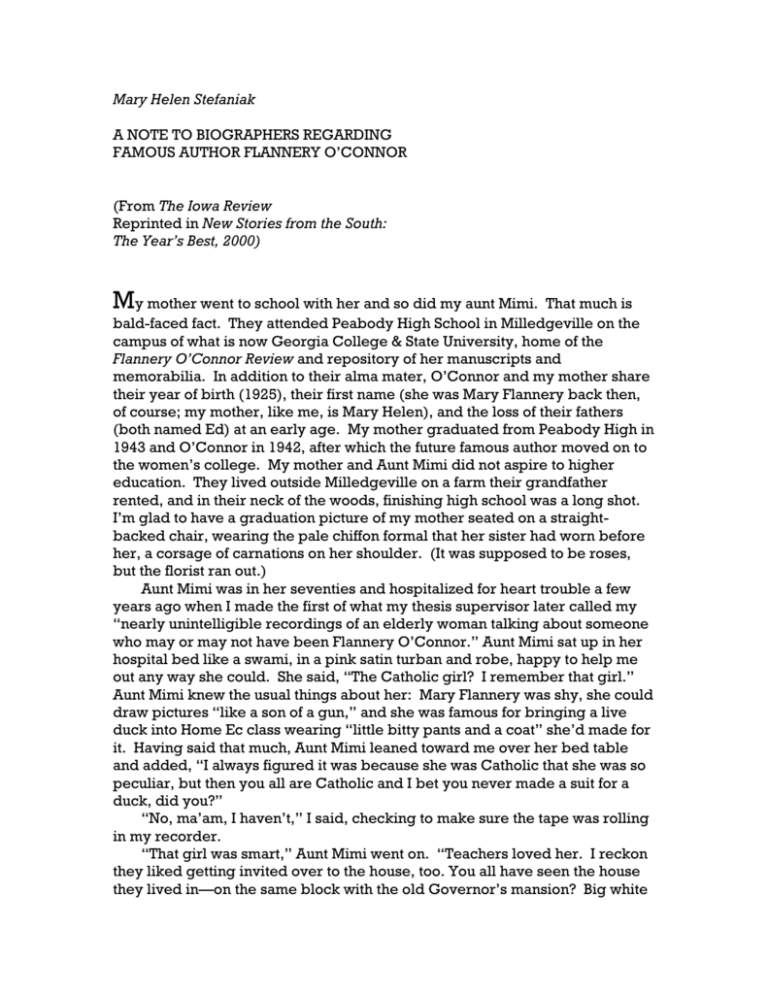
Mary Helen Stefaniak A NOTE TO BIOGRAPHERS REGARDING FAMOUS AUTHOR FLANNERY O’CONNOR (From The Iowa Review Reprinted in New Stories from the South: The Year’s Best, 2000) My mother went to school with her and so did my aunt Mimi. That much is bald-faced fact. They attended Peabody High School in Milledgeville on the campus of what is now Georgia College & State University, home of the Flannery O’Connor Review and repository of her manuscripts and memorabilia. In addition to their alma mater, O’Connor and my mother share their year of birth (1925), their first name (she was Mary Flannery back then, of course; my mother, like me, is Mary Helen), and the loss of their fathers (both named Ed) at an early age. My mother graduated from Peabody High in 1943 and O’Connor in 1942, after which the future famous author moved on to the women’s college. My mother and Aunt Mimi did not aspire to higher education. They lived outside Milledgeville on a farm their grandfather rented, and in their neck of the woods, finishing high school was a long shot. I’m glad to have a graduation picture of my mother seated on a straightbacked chair, wearing the pale chiffon formal that her sister had worn before her, a corsage of carnations on her shoulder. (It was supposed to be roses, but the florist ran out.) Aunt Mimi was in her seventies and hospitalized for heart trouble a few years ago when I made the first of what my thesis supervisor later called my “nearly unintelligible recordings of an elderly woman talking about someone who may or may not have been Flannery O’Connor.” Aunt Mimi sat up in her hospital bed like a swami, in a pink satin turban and robe, happy to help me out any way she could. She said, “The Catholic girl? I remember that girl.” Aunt Mimi knew the usual things about her: Mary Flannery was shy, she could draw pictures “like a son of a gun,” and she was famous for bringing a live duck into Home Ec class wearing “little bitty pants and a coat” she’d made for it. Having said that much, Aunt Mimi leaned toward me over her bed table and added, “I always figured it was because she was Catholic that she was so peculiar, but then you all are Catholic and I bet you never made a suit for a duck, did you?” “No, ma’am, I haven’t,” I said, checking to make sure the tape was rolling in my recorder. “That girl was smart,” Aunt Mimi went on. “Teachers loved her. I reckon they liked getting invited over to the house, too. You all have seen the house they lived in—on the same block with the old Governor’s mansion? Big white 2 columns and all? What d’you reckon they’d do with all the rooms in a house that big?” My mother spoke up from her chair under the TV. Her voice is faint and echoey on the tape because she’s too far away from the microphone, her Georgia accent faded by decades of living in Milwaukee, Wisconsin. “They probably closed part of it off,” my mother said, “like Mrs. Sawyer did her place in Hopewell.” Before I could ask about this Mrs. Sawyer, Aunt Mimi said, “They might have had a couple rooms set aside for him.” “Him?” I said. I try to avoid leading questions. “Her daddy,” Aunt Mimi said confidentially. “He was real sick. I believe it was something pretty ugly in the end.” “Lupus,” I said. They didn’t have the drugs they have now. Aunt Mimi continued. “That’s why they come to Milledgeville in the first place from Atlanta. You can’t hardly blame that girl for being glum.” “I believe it was Savannah, Mimi,” said my mother. “They came from Savannah.” “Maybe so,” Aunt Mimi said. “Anyhow, I know he died not too long afterwards.” “It was a few years,” said my mother. “February ’41,” I said. “That sounds about right,” said Aunt Mimi. “Did you go to the funeral?” I asked her. “Whose?” she said. “Mr. O’Connor’s.” Aunt Mimi gave me a look. “Of course I didn’t go to Mr. O’Connor’s funeral. They were Catholics, honey. He would’ve got buried out of the Catholic church. St. Joseph’s. Little bitty church about the size of this room.” My mother spoke up again. “St. Joseph’s is in Macon, Mimi. The Catholic church in Milledgeville is Sacred Heart.” “I call them all St. Joseph’s,” Aunt Mimi said, and she leaned back against the bed and closed her eyes. From across the room, my mother made a face at me to say that her sister was too tired to talk anymore. I raised my eyebrows to say I could see that and pushed STOP on the recorder. My mother didn’t remember the dressed duck in Home Ec, but she did report having seen Mary Flannery O’Connor with the Catholic priest one time in a luncheonette downtown. My mother was not a Catholic herself, not yet. That came after she met my father—an Army Air Corps corporal from Milwaukee, who used to stand on the bus from the base into Macon to save the crease in his pants. She married him in 1945, and when he shipped out, she moved up north to live with his family, a houseful of Hungarian Catholic immigrants who couldn’t understand a word she said. Back in high school, my mother was still a de facto Methodist in a family of Baptists—the one kid who refused to dunk her head in the water—but she knew by his outfit that the man 3 she saw with Flannery O’Connor in the luncheonette at Rosie’s had to be the Catholic priest. The way I picture it, my mother, Mimi, and their older sister Dottie are in Rosie’s Ten-Cent Store after school one day. They’re hanging around the cosmetics counter, examining pots of rouge and shaking little round boxes of Pond’s Dusting Powder. They’re touching blue heart-shaped bottles of Evening in Paris that they can’t afford to buy, waving the bottles under one another’s noses, hoping to catch a whiff through the glass stoppers. A clerk stationed beside the cash register is watching them like a field mouse watching three hawks. My mother and her sisters are tall, sturdy, nicelooking girls: two brunettes and Dottie, a redhead, who is past twenty now and married already. At 5’6” my mother is the smallest of the three, the one whose cotton dress (made by Mimi from a pattern in Home Ec) is clean and ironed and smartly belted (another of Mimi’s fashion ideas) but still too big for her. They’re all three busy figuring prices and deciding what their pooled resources—Dottie’s tips and some quarters they’ve earned picking cotton— might buy, when a girl’s voice floats over to them from another part of the store, saying things like “I dunno, Father,” and “Do you think so, Father?” It’s the “Father” part that catches my mother’s ear, and she turns and looks across Rosie’s Ten-Cent Store to the luncheonette, where the Catholic girl is sitting in a red booth with Father Whatsisname. Now my mother knows that, whatever he may be, the priest is not the Catholic girl’s father, because the Catholic girl’s father is dead. He died last winter of some unsightly disease, or so she heard at school. My mother’s own father has been gone much longer, having succumbed to a massive sinus infection at the Veterans Hospital on Christmas Day, 1936, when she was eleven. To make matters worse, he was preceded in death by her mother, who had died in childbirth the previous fall. All the while I was growing up, whenever I objected to what I considered my mother’s nagging and meddling in my life, I had to hear about how she would be only too glad if she had had a mother to interfere with her life. One time I came back with, “You only think so because she died!” It’s hard to have to remember that you’re the same person who once said a thing like that to your mother. My mother has always had less to say about her father—a carpenter who spent weeks and months away from home on construction jobs—but she does have one very clear memory of him sitting on a kitchen chair next to the stove with the new baby in his lap, a tiny head cradled on his knees and little feet kicking at the folds of his trousers. The baby’s wearing only a diaper. Her barrel chest and belly are mottled pink, like marble. The rest of the children are gathered around—my eleven-year-old mother and Mimi and little Eddie, Jr., previously the youngest, and Dottie, the oldest, at sixteen. My mother remembers how the kerosene lamp on the table made all their faces look yellow, and how if you touched the baby’s palm she’d grab your finger and hold on. Their father was saying that the best thing they could do for their new little sister was to give her to Uncle Rutherford in Tallahassee, because 4 Uncle Rutherford and his wife didn’t have any children and would raise her like their very own. My mother and her sisters tried to talk him out of it. They said three big girls could take care of one little baby, couldn’t they? But their father had already made up his mind, knowing, perhaps, as his daughters did not, that no matter how bad things are, they can always take a turn for the worse. Sure enough, right before Christmas that same year, my mother’s father went into the Veterans Hospital, where he died, leaving the rest of the orphans to their grandparents, except for Dottie, who took herself off her grandparents’ hands by dropping out of high school and quietly getting married. Something about the way Mary Flannery O’Connor said, “Do you think so, Father?” to the priest in the luncheonette must have made my mother recall that scene in the kitchen. She was going on sixteen herself now, almost five years had passed since her father died, but suddenly she was seized with longing. Maybe all she wanted was to say it herself: Father. Do you think so, Father? Do we have to, Daddy? Do you reckon Mama’d want us to give her away? Do you? Daddy? Whatever she was thinking, all of a sudden the bottle of Evening in Paris became a blue blur in her hand and she was crying in public, a big girl—almost a woman—crying like a baby right there at the cosmetics counter, in Rosie’s Ten-Cent Store. “What in the world is the matter?” her sister Dottie said when she saw, and then Mimi moved in, putting her arm around my mother, leaning so close that strands of her dark hair clung to my mother’s tears, whispering in her ear, “Are you sick, sugar? You got cramps?” In a voice gummy with tears, my mother could only say, “He ain’t her father.” “Who ain’t whose father?” said Dottie. My mother shot a look at the luncheonette. “The Catholic girl?” Mimi said. My mother nodded, and they all looked at the red booth where Mary Flannery O’Connor was sitting across from the priest. She was not a particularly attractive girl, although Mimi believed she could have been better looking if she tried. Sitting across from her in class, my aunt Mimi had thought more than once that if she could afford to live in a house like the one that Mary Flannery O’Connor lived in, she would also shell out a few dollars for some clothes that didn’t look as if she’d made them herself. (In fact, O’Connor’s mother made them for her.) While Mimi and Dottie and my mother watched, Mary Flannery O’Connor tugged at first one and then the other of her long velvet sleeves. They heard her say something like, “Well, Father, I’ll tell her what you said.” Meanwhile (and to me this is the most amazing part since I can count on one hand the number of times I’ve seen my mother cry in my lifetime), she was still blubbering by the cosmetics counter, repeating tragically, “He ain’t her father.” 5 “Of course he’s not,” Dottie said. “That’s what all Catholics say to their what-do-you-call-it, their priests. You know that.” “He ain’t,” my mother said again. She was unable to explain why this was suddenly a problem for her, but the anguish in her voice worked on her sister Mimi like a call to arms. Mimi straightened her shoulders and pressed her lips together, causing Dottie to exclaim, “Mildred! What are you thinking to do?” My aunt Mimi has mellowed with the years, but they tell me she was a warrior in her day—broad-shouldered, small-waisted, wide-hipped, slimankled, and tall—almost 5’9” in her stocking feet before she started to shrink with age, which happens sooner than you think. Mimi shook off the hand that Dottie had laid on her arm and strode away from the cosmetics counter. Before my mother and Dottie could decide if they should run out the door of Rosie’s Ten-Cent Store and into the next county right now, Mimi was standing next to Mary Flannery O’Connor’s table and looking down at the future famous author. It was to O’Connor’s credit, my mother would say, that she didn’t flinch or duck her head but looked the formidable Mimi full in the face, while the priest looked up and down from one to the other like somebody measuring the distance between two points. The first thing Mimi said was “Excuse me, sir,” to the priest, a pale fellow with rounded shoulders. Then Mimi turned to O’Connor and, putting her hands on her hips, she said flat out, “Your daddy is dead and you know it. So how come you’re calling this man ‘father’? He ain’t your father any more than I am.” Until recently, whenever I imagined this moment, I would try to make that priest keep quiet and let the future famous author say something that Aunt Mimi might remember, or my mother overhear, something they could report to me some 50 or 60 years later. I know it didn’t happen that way. I know the priest said, “See here, young lady!” and proceeded to explain to my aunt Mimi certain points of Catholic dogma regarding the sacrament of Holy Orders and priests as spiritual fathers and the like, to which Mimi responded, after waiting politely for him to finish, “Beggin’ your pardon, sir, but us Baptists don’t put too much stock in spiritual fathers.” She drew herself up straighter and added, “Exceptin’ God Almighty.” Mary Flannery O’Connor’s eyes must have widened at the audacity of my aunt Mimi, while the priest’s face turned a shade of red significant enough to attract the attention of my mother’s aunt Gladys, who had just stopped on the sidewalk outside the big front windows of the store, having left her husband in Garrison’s Grill with his Packard parked out front while she ran down to Rosie’s to pick up some thread. From the sidewalk, standing in the shade of a faded awning, Gladys had looked inside the store and immediately spotted Dottie and Mary at the cosmetics counter, turning their pockets out for a pair of scowling salesclerks. Then, as if that weren’t bad enough, the scene in the luncheonette caught her eye. From Mimi’s stance and the red face and Roman collar on the man in the booth, Gladys couldn’t help but conclude that her 6 niece was having an argument with the Catholic priest. Knowing Mimi, Gladys thought, they were arguing religion. Aunt Gladys usually tried to make allowances for her dead sister’s daughters, ignoring their oddities as much as possible, but this looked like a situation that required the intervention of her own special talents. Her husband used to say that if she hadn’t been born female, Gladys would have made a first-rate salesman or a powerful preacher. (“Six to one, half-a-dozen to the other,” Gladys would say about that.) Within minutes of her entry into Rosie’s Ten-Cent Store, Aunt Gladys had rescued Mary and Dot from the irate sales staff. Liberated, the girls fled to a corner in the rear of the store, by the hanging rolls of oilcloth, where they had a clear view of their aunt bearing down on her next objective: the red booth in the luncheonette. Now we’re getting to the part of the story that disturbed my thesis supervisor the most. Although no one could have known it at the time, I believe that my mother and her sisters were about to witness an important moment in the life of Flannery O’Connor. It was the kind of moment the famous author liked to inflict in her stories on the characters she loved best, which is to say, on the ones most likely to be shot, gored, drowned, or abandoned. You know the kind of moment I mean. Remember the black lady who gets on the bus and sits down right across from Julian and his mother, wearing the same damn purple hat that Julian’s mother is wearing? And remember how Julian—unaware that he’s the main character in a Flannery O’Connor story—thinks smug thoughts about the lesson his aging Southern belle of a mother must be learning from her hat-shaped slice of humble pie? Little does he know, as he watches his mother’s face go gray, that he’s looking in the wrong direction, attending to the wrong detail, that he—not she—is the author’s target. Of course, in real life, your mother doesn’t have a brainaddling stroke just to prove that you’re a bigger bigot than she is. In real life, the moments of grace are never so clear cut, the gestures never so totally right as all that. Still, things do happen that change people forever From the rear of Rosie’s Ten-Cent Store, my mother and her sister Dottie watched the little drama in the luncheonette up front unfold like a silent movie. They saw Mimi stepping back from the red booth to make room for Aunt Gladys. They saw Aunt Gladys fast-talking Father Whatsisname, who was on his feet by now, trying to look taller than the women. Gladys strung him along for a few minutes, the fingers of her left hand splayed on her breastbone to indicate how deeply mortified she was by her niece’s behavior. Then she offered her hand for a shake. From the back of the store the girls saw the priest reach for their aunt Gladys’s hand. They saw him stop for an awkward moment with his right hand stuck out in front of him like a pump handle, and then he recovered, taking their aunt’s left hand—the one she’d offered in the first place—in both of his and giving it a priestly squeeze. Most important, from the biographer’s point of view, they saw Mary Flannery O’Connor, still seated in the red booth, her glass of Green River untouched in 7 front of her, and her blue-gray eyes on a level with the end of Gladys’s right arm. Now the fact is that Aunt Gladys’s right arm ends about an inch below the elbow in a little knob of flesh that peeks out of her three-quarter-length sleeve from time to time, when she forgets to keep her apron tossed over it. She was born that way, with a regular left arm and a short right one, a deprivation that did not keep her from finding herself a Packard-owning husband (long before the county got overrun with horny enlisted boys, she liked to point out) or from giving birth to a two-armed son. If I have so far neglected to mention her arm, my intention was not to manipulate my dear reader—as I was accused in the margins of my graduate thesis. It was only to make you see my great-Aunt Gladys as other people saw her, as you would have seen her yourself if you had met her back then. The first thing people noticed about Aunt Gladys was her eyes, sky-blue, wide open, welcoming as a pair of outstretched arms. Even now, with cataracts clouding them, her eyes take you right in, they make an insider out of you before she opens her mouth to speak, which is the second thing people noticed about Aunt Gladys—her voice. It’s high-pitched and wavery now, but it used to be rich and relentless. (Aunt Mimi tells me, by the way, that if I could have taped that voice, my thesis supervisor would be singing a different tune.) The story goes that Great-Uncle Jack fell in love with Gladys at first sight and sound, helpless to resist the double whammy of her voice and eyes across the counter of the baked goods booth at a church bazaar. He didn’t even see the short arm until he called on her days later. “My goodness, Gladys!” he exclaimed when she came to the door. “Whatever did you do to your arm?” The point is, nobody sees Aunt Gladys’s arm; not even the priest noticed it until he reached for a hand to shake. O’Connor was looking in the wrong place, that’s all—she was attending to the wrong detail. Maybe, having watched her father scab up and die, she was already on the lookout for proof that the flesh was weak, wrong, fatally flawed, and finally useless. Maybe that’s what kept her gaze fixed like a dissecting pin on that stub of an arm. I wish I could have been there. I wish I could have put my finger under Mary Flannery’s chin right then and tilted it up, up to Aunt Gladys’s face, which was kindness itself, up to her eyes, which were steady like O’Connor’s and blue, but without the clouds, without the storm approaching, blue—I have to say it—as the vault of heaven. But I wasn’t there, and as Aunt Gladys stood talking beside the red booth, her short right arm kept peeking out at Mary Flannery O’Connor, who had forgotten by now about the priest across the table from her and the strange confrontation with a girl she hardly knew from school. Mary Flannery was paying no attention to Mimi now, nor did she see my mother and Dottie leaning forward, shoulder to shoulder, in the back of the store. In fact, if you had told her that Gladys was speaking to the priest in Latin, Mary Flannery O’Connor couldn’t have said that you were wrong. Her whole attention was 8 pinned to the little knob of flesh at the tip of Gladys’s arm, which poked in and out of sight like the pink snout of a little animal playing a grotesque game of hide-and-seek in her sleeve. The rest of Great-Aunt Gladys, like my mother and her sisters, shrank in the future famous author’s mind to distant points of local color. For Flannery O’Connor, with lupus lurking in her cells and Jesus lodged in her heart, only the tip of Gladys’s right arm was a revelation. It was an early encounter with the enemy, it was a blind prophet, it was like one of her own babies, it was like the same damn hat.
